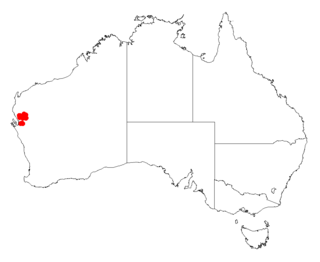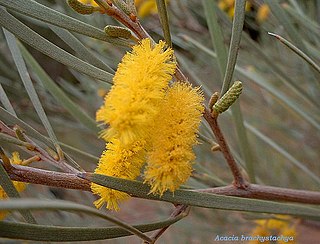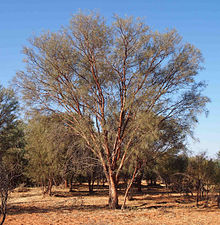
Acacia aneura, commonly known as mulga or true mulga, is a shrub or small tree native to arid outback areas of Australia. It is the dominant tree in the habitat to which it gives its name (mulga) that occurs across much of inland Australia. Specific regions have been designated the Western Australian mulga shrublands in Western Australia and Mulga Lands in Queensland.

Acacia anastema, commonly known as sandridge gidgee or just gidgee, is a tree in the family Fabaceae. Endemic to Western Australia, it occurs within a fairly small area of semi-arid land east of Carnarvon.

Acacia brachystachya, commonly known as umbrella mulga, turpentine mulga or false bowgada, is a shrub in the family Fabaceae. The species occurs in mulga and heath communities on sandhills and rocky ridges in all mainland states of Australia, except Victoria.

Acacia citrinoviridis, commonly known as black mulga, river jam, milhan or wantan, is a tree in the family Fabaceae that is native to western Australia.

Acacia coolgardiensis, commonly known as sugar brother or spinifex wattle, is a shrub in the family Fabaceae. Endemic to Western Australia, it is widely distributed in the semi-arid spinifex country from Carnarvon to Kalgoorlie.

Acacia coriacea, commonly known as river jam, wirewood, desert oak, wiry wattle or dogwood, is a tree in the family Mimosoideae of family Fabaceae. Indigenous Australians know the plant as Gunandru.

Acacia cuspidifolia, commonly known as wait-a-while or bohemia, is a tree in the family Fabaceae. Endemic to Western Australia, it occurs on the floodplains east of Carnarvon.

Acacia grasbyi, commonly known as miniritchie, is a shrub or tree in the family Fabaceae that is endemic to parts of arid western and central Australia.

Acacia hemiteles, commonly known as tan wattle, is a shrub in the family Fabaceae. It is widely distributed throughout south central Western Australia. It was formerly thought to be endemic to Western Australia, but has recently been collected near Maralinga in South Australia. Tan wattle is a good coloniser of disturbed or burnt ground, and is therefore often seen in mining areas.

Acacia tetragonophylla, commonly known as curara, kurara or dead finish, is a tree in the family Fabaceae that is endemic to arid and semi-arid parts of central and western Australia.

Acacia subtessarogona, commonly known as spreading gidgee, is a tree in the family Fabaceae and the subgenus Juliflorae that is native to a small area in western Australia.

Acacia sclerosperma, commonly known as limestone wattle or silver bark wattle, is a tree in the family Fabaceae. Endemic to Western Australia, it occurs on floodplains and along water-courses throughout the arid north-west corner of the State.

Acacia quadrimarginea, commonly known as granite wattle or spreading wattle, is a tree in the family Mimosaceae. Endemic to Western Australia, it occurs through arid south-central Western Australia. It is common on granite, but also occurs on sand and clay, and is often seen along creeklines in rocky hills.
Acacia ramulosa var. linophylla, commonly known as bowgada, wanderry mulga, horse mulga or sometimes wanyu, is a subspecies of the tree species Acacia ramulosa, with which it shares several common names. While the parent species is found throughout arid Australia, this subspecies is much more restricted, being found only on loose red sand in south central Western Australia and sporadically in South Australia. The species was formally named Acacia linophylla until 2001, when it was recognised as a variety of Acacia ramulosa.

Acacia fuscaneura, commonly known as sooty wattle, is a tree belonging to the genus Acacia and the subgenus Juliflorae. It is native to arid areas of central Australia.

Acacia lasiocalyx, commonly known as silver wattle or shaggy wattle, is a tree or shrub belonging to the genus Acacia and the subgenus Juliflorae.

Acacia ramulosa, commonly known as horse mulga or bowgada wattle, is a shrub belonging to the genus Acacia and the subgenus Juliflorae endemic to arid areas of Australia.

Acacia prainii, commonly known as Prain's wattle, is a shrub or tree belonging to the genus Acacia and the subgenus Phyllodineae endemic to Australia.

Acacia oswaldii, commonly known as boree, umbrella wattle, umbrella bush, whyacka, middia, miljee, nella and curly yarran, is a shrub or tree of the genus Acacia and the subgenus Plurinerves.

Acacia macdonnelliensis, commonly known as the MacDonnell mulga or the Hill mulga, is a species of Acacia native to central Australia. The Indigenous Australians the Alyawarr peoples know the plant as irrar, the Kaytetye know it as arleth-arlethe or arwele arleth-arlethe and the Western Arrernte peoples know it as irrkwarteke.




















